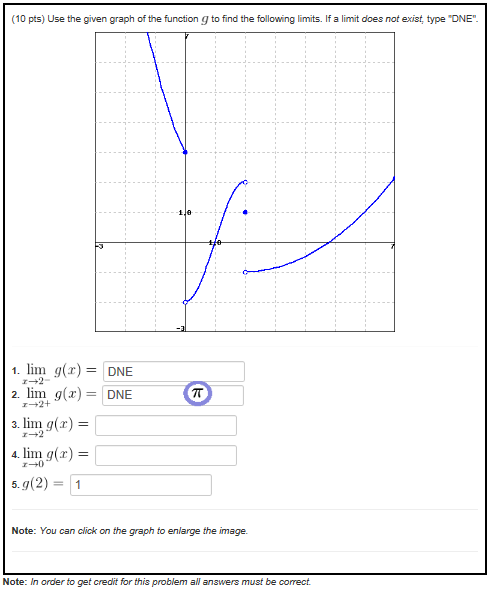How would I find the limits of the function below?
 Webwork
Webwork
We were assigned a whole bunch of homework for the Thanksgiving Break, and to my surprise, we've stopped doing trig and moved into calculus. We've had no discussion or previous exposer to these types of problems, so I'm just blindly trying to figure out what's going on. I understand what a limit is, but what on earth are the difference between the closed and open dots? How to I find a limit when there are multiple points on the y axis? What is the difference between something like "x-->2-" "x-->2+" or "x-->2" ?
Webwork
We were assigned a whole bunch of homework for the Thanksgiving Break, and to my surprise, we've stopped doing trig and moved into calculus. We've had no discussion or previous exposer to these types of problems, so I'm just blindly trying to figure out what's going on. I understand what a limit is, but what on earth are the difference between the closed and open dots? How to I find a limit when there are multiple points on the y axis? What is the difference between something like "x-->2-" "x-->2+" or "x-->2" ?
1 Answer
This is a bit difficult to explain. First it's best to get the notation figured out.
This is called a left hand limit, and it means you are approaching the limiting point from the left.
This is called a right hand limit, and it means you are approaching the limiting point from the right.
This is called a two handed limit, and it means you are approaching the limiting point from the both sides at once.
For
If
The open point means the function is undefined at that point, but this dosen't mean a limit can't exist at that point. The solid dot just means a point where the function is defined, even if it is just a single value, as in the diagram.
For 1):
We are approaching from the left close to
For 2):
We are approaching from the right close to
For 3):
This time we are approaching from both sides. Now, if the solid point was not there we would conclude that the limit didn't exist, because we would be on the curve above the axis from the left and the curve below from the right and as we know from the last two limits these are not the same value as each other. But because the solid point is there and it would be possible to plug the
For 4):
Approaching from the left we are on the curve above the x axis heading towards
So:
1) = 2
2) = -1
3) = 1
4) is undefined. DNE.
Limits can be damned confusing at times, and they take a fair amount of practice and time to get down. You may be better off watching some videos on places like You Tube. Maybe this has been helpful, maybe not.
Good luck.

